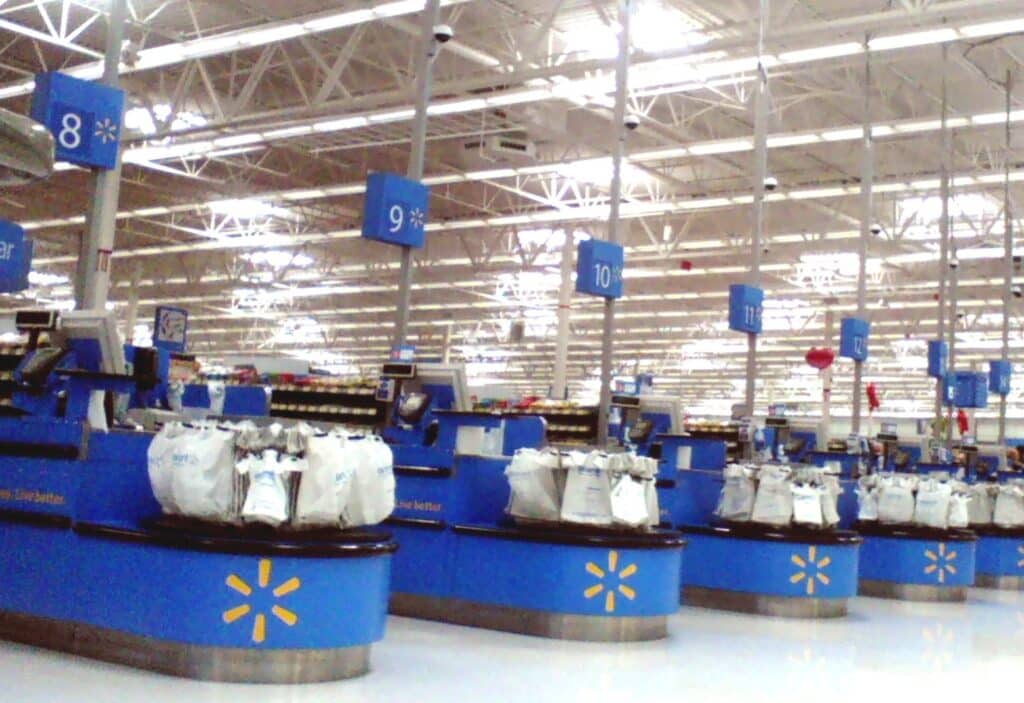
Maybe those digital price tags aren’t such a bad idea. Walmart’s plans to replace paper price tags with digital ones have raised suspicions among some shoppers. But, done right, the new high-tech tags could help ward off lawsuits, like the one newly filed by another Walmart shopper who says deceptively inaccurate price tags are costing shoppers millions and lining Walmart’s pockets.
Quina Myers of Philadelphia is the latest Walmart shopper to sue the retailer for allegedly displaying one price at the shelf and charging a higher price at the register.
On at least two occasions earlier this year, she said she went shopping for various food and baby products at her local Walmart, and only after checking out and reviewing her receipt did she notice that she was charged more for some products than the price listed at the shelf.
“The information on Rollback stickers, price stickers, and yellow stickers are relied on by consumers to clearly and accurately depict Walmart’s proposed price,” the lawsuit reads. By charging a different price at the register, she said Walmart has “misled and/or deceived consumers about pricing of the product and what the customer will be charged.”
Myers’ lawsuit was filed weeks after a federal appeals court revived a similar case that a lower court had thrown out. Back in 2022, Ohio resident Yoram Kahn sued Walmart after saying he, too, was overcharged for multiple items at a Walmart store. And he produced the receipts and photos to prove it.
His lawsuit said a package of chocolate cupcakes with a shelf price of $3.12 came up as $3.48 at checkout – an 11% markup. A jar of $2 salsa rang up as $2.28, a 14% increase. And a bottle of strawberry syrup that should have cost $2.48 cost him $2.87, 15% more than advertised. In total, he said he paid $1.89 more than he should have – a small amount, but multiplied by potentially millions of shoppers buying tens of millions of items, it could really add up.
“Walmart’s shelf pricing frequently misrepresents the prices consumers are charged at the point of sale,” his lawsuit read. “As a result, consumers fall victim to a classic ‘bait and switch.’” He accused Walmart of “unfair and deceptive business practices” and claimed the retailer “is well aware that it is deceiving its consumers.”
In its response, Walmart argued that any pricing discrepancies were “no more than a mere error” and “merely reflect the real-world reality that it is virtually impossible for a retailer to match shelf pricing and scanned pricing 100% of the time for all items.” The response went on to criticize Kahn for suing. He “received a receipt at the time of purchase reflecting the alleged price discrepancy,” Walmart said. “But instead of complaining to the cashier or seeking a refund, he returned to the shelf to photograph the receipt alongside the alleged current shelf pricing,” then filed a lawsuit “to extract millions of dollars from Walmart… based on this $1.89 discrepancy.”
The court agreed and dismissed Kahn’s case last year. But in July, an appeals court came to a different conclusion. “It is neither ‘unreasonable’ nor ‘fanciful’ for consumers to believe Walmart will sell them its merchandise at the prices advertised on its shelves,” the court’s decision read. And merely providing customers with a receipt and expecting them to notice any price differences is no defense. “Under Walmart’s approach to these pricing inaccuracies, consumers must keep track of the advertised shelf prices for all the items they intend to purchase, either by memory or by documenting shelf prices while shopping,” the appeals court explained. “Next, after paying and obtaining a receipt, consumers would need to compare the scanned prices with the shelf prices for all the items… Who does that?”
The appeals court decision went on to say that “reasonable consumer behavior does not require shoppers to audit their transactions and to overcome those additional hurdles just to ensure that they receive merchandise at the advertised shelf prices.” And “even if some low level of price discrepancies is unavoidable, Walmart is not alleged to have undertaken any preventive or remedial measures to mitigate overcharges.”
So the appeals court revived the case, sending it back to the lower court to try again.
As both of these cases now make their way through the court system, Walmart is in the process of replacing many of these allegedly problematic price tags with new digital ones. Back in June, Walmart announced it would be installing digital price labels in more than 2,000 of its stores over the next couple of years. Walmart said digital tags, which can be updated with the touch of a button, would improve efficiency, productivity – and accuracy. “Customers can shop with confidence, knowing they are getting fair and consistent prices,” Walmart’s digital shelf tag provider explained.
Some shoppers, however, have expressed concerns that easily-changed digital price tags could allow Walmart to surreptitiously raise prices whenever it wants to. What if the price at the shelf changes after you’ve put an item in your cart, and you don’t find out until you’ve paid for it?
That’s a question for a future shopping trip, and perhaps a future lawsuit. In the meantime, Walmart will have to defend itself against good old-fashioned “false, misleading, unfair and deceptive” paper price tags, according to Myers’s case. As for Kahn’s case, depending on how he fares in his second try, that $1.89 overcharge could turn out to cost Walmart a whole lot more.
Image source: frankieleon











I certainly hope Walmart has to give back money to the consumer’s . I shop at Walmart and now I will watch every price closely. What a SHAME that it has come to this. “SHAME ON YOU WALMART”!!!
WAIT TILL TRUMP HEAR’S ABOUT THIS!!!!
Oh please the next thing he does that helps the citizens of this country will be the first. Trumps number one concern is Trump. Always has been always will be. Just because he says he will, doesn’t mean he will. He expects people to take him no on his word, that is something I will never do. American con man.